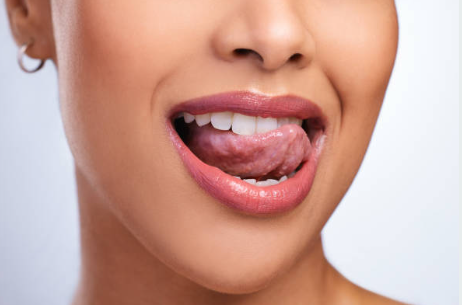What Does the Colour of My Tongue Mean?



The tongue is an essential organ in the body and it can be used as a window to our health. The colour and texture of the tongue can tell us what’s going on in your body. Your tongue can indicate many health issues, from diabetes to nutritional deficiencies. Know what your tongue looks like and what it means by taking simple steps at home, such as brushing your teeth regularly and eating foods high in Vitamin A or potassium, including fruits such as bananas or leafy greens!
The texture and colour of your tongue can differ from another person depending on the following:
Age
Race
Gender
Health status
Diet (especially vitamin C and iron intake)
Oral hygiene habits, especially brushing and flossing regularly
It’s important to note that a healthy diet is not the only factor affecting the tongue’s appearance - if you have a history of smoking or heavy alcohol consumption, your tongue may be more likely to have changes in colour and texture as well as other oral and dental health problems like bad breath due to bacteria build-up on the surface of your tongue! The same goes for people who have diabetes or have some digestive issues that cause stomach acid production, such as heartburn (also known as GERD).
Your tongue is an excellent indicator of your overall health. The colour and texture of your tongue can tell you if you have an infection in your mouth, stomach or intestines. It may also signify other medical conditions such as diabetes, liver disease or kidney failure.
Tongue reading is a technique that allows you to examine your tongue and make deductions about your health based on the appearance of the organ. It’s often used in conjunction with traditional Chinese medicine (TCM), a system of diagnosis and treatment that dates back thousands of years. It is an ancient practice and one that’s still used today.
In China, for example, it’s common to see people using tongue reading as part of their daily health check-ups. You can have an impression about a person just by looking at their tongue’s colours and textures! It’s believed that the tongue can reveal information about a person’s health. While there are no proven scientific benefits of tongue reading (aside from the fact that it can be used to diagnose certain infections), many people still find it helpful in determining what foods might help improve their health.

A healthy tongue will be pink or red and moist. It should be free of cracks, sores, or bumps. If you’ve ever had a sore on the back of your throat that gave you trouble swallowing or talking, then you’ll know what an irritated tongue feels like. That’s not normal, though—it’s evidence that something is wrong with your immune system. If there are no white spots on your tongue (which may indicate oral thrush), nor black spots (which could mean cavities), then consider yourself in good health!
In addition to a person’s tongue colour, a healthy tongue’s shape is usually somewhat oval-shaped, but it can also be slightly elongated. It should never appear too small or large for your mouth. A coarse texture is also a good sign that all is well with your tongue. Any loss of texture may be due to trauma or illness, so if there have been no recent incidents in which your tongue was injured or overly stressed, it should have its typical roughness.
As with any other body part, your tongue may vary in thickness. A thin tongue is usually a sign of dehydration, while a thick tongue can mean you’re dehydrated or ill. A healthy tongue should be slightly thicker at the back than at the front, so if yours appears too thin, consider drinking more water!
If you’re worried about your tongue’s health, talk to a dentist who can examine you and ensure everything is okay.
When your tongue is white, it can signify several things. White tongues are usually due to dehydration, but there may also be something else going on. A fungal infection, thrush or poor oral hygiene could also explain why your tongue has turned white.
A black hairy tongue (also called leukoplakia) is caused by a buildup of dead skin cells on your tongue’s surface. It can be caused by the lack of good oral hygiene and is usually treated with a tongue scraper, but it can also arise as a side effect of certain medications used to treat high blood pressure or heart disease. It might also be due to an infection with fungi in your mouth!
Red spots on the tongue can signify infection. You must see a doctor immediately if you notice red patches or spots on your tongue. Red spots on the tongue can be caused by many different things, including:
A fungal or bacterial infection
Stress due to overwork or fatigue
Infection with Epstein-Barr virus (EBV)
Strep throat
Geographic tongue is a benign condition associated with red and white patches on the tongue. It can be found in at most 20% of the population and is among the most common causes of oral complaints.
Geographic tongue gets its name because of its appearance: an area of smooth white or grey discolouration that travels along the side of your tongue as it moves from side to side (think “geography” book). The patches are usually painless, but a burning sensation often accompanies them in people who have them. Geographic tongue can also cause ulcers and bleeding, so you should see a doctor if these symptoms appear.
Orange and yellow tongues signify jaundice when your liver doesn’t work properly and builds up too much bilirubin (a pigment in bile). When this happens, bilirubin passes into your bloodstream and starts to colour the tissues in your skin. It is why it may turn yellowish if you ever have a cut or bruise on your arm or leg that doesn’t heal as quickly as usual. If you have an orange-yellow tinge to your entire tongue (not just one part), it could mean that something else is going on with how well your body is processing bile.
Orange or yellow discolouration of tongues may also be caused by dehydration (not having enough water), so keeping hydrated with plenty of liquids daily can help keep them looking normal instead of bright orange!
If your tongue is bumpy or ridged, this can be a sign of vitamin deficiency. It can also be caused by poor oral hygiene and may indicate that you’re not getting enough vitamins from your diet. Vitamin deficiencies are common in people with eating disorders and those with weight loss surgery. This type of tongue is also associated with iron deficiency anaemia, which causes the body to have a low red blood cell count (RBC).
It could also mean that you’re taking medication for epilepsy or a bipolar disorder called lithium carbonate, which has side effects like dry mouth and thirst and changes in taste perception. Another possible cause is candidiasis (also known as thrush), caused by an overgrowth of yeasts generally found on our skin. Still, if left untreated, it can affect mucous membranes, such as inside the mouth.
The tongue may turn purple or can get a blue tinge due to the following:
Smoking
Medication
Food, such as blueberries or red wine (if you eat the skin of a blueberry, it will stain your tongue)
Dehydration and vitamin deficiency are also common causes of purple-tongued mouths.
A blue tongue can be caused by dehydration, but it is often associated with other symptoms like headaches, dizziness and irritability. The colour change is harmless and will go away within a few hours.
A purple tongue can be caused by a low level of the B vitamin riboflavin, which helps your body release energy from food. This type of purple tongue is not related to an infection or other condition in your mouth. Kawasaki disease and poor circulation of blood can also cause this colour.
Your tongue can turn brown due to several factors. Smoking, for example, can stain your tongue. It’s also common for people who eat or drink lots of coffee or tea to have brown tongues. Gastroesophageal reflux disease (GERD) and acid reflux may also cause your tongue to turn brown.
So, what should you do if you’re concerned about your tongue colour? If the colour is a cause for concern and lasts longer than a few days, contact a doctor as soon as possible. An underlying health issue may sometimes be present and require treatment. However, most of these conditions are not severe or require any specific treatment beyond rest and hydration (this includes white spots on your tongue).
Learn more about tongue health with Welzo! Read our article on how to treat herpes on the tongue and what are the HIV mouth symptoms.
Plus get the inside scoop on our latest content and updates in our monthly newsletter.